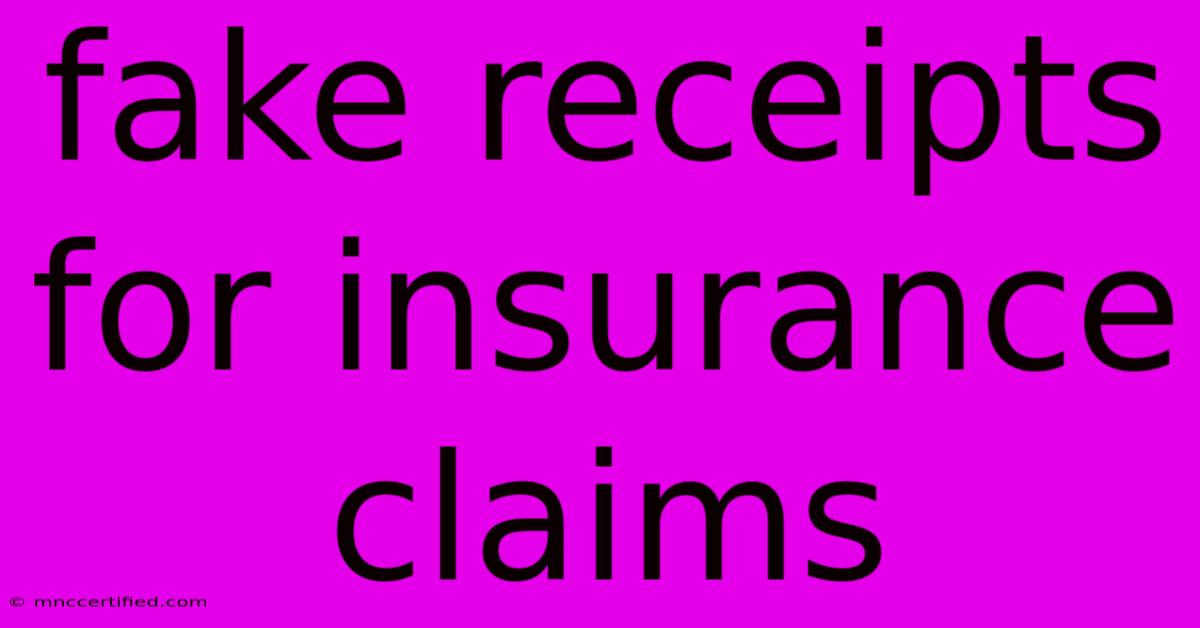Fake Receipts For Insurance Claims

Table of Contents
The Risky Road of Fake Receipts for Insurance Claims: A Comprehensive Guide
Submitting a fake receipt for an insurance claim might seem like a quick solution to a financial problem, but it's a dangerous path fraught with severe consequences. This article explores the ramifications of insurance fraud, offers insights into how insurance companies detect fraudulent claims, and provides advice on ethical and legal alternatives.
Understanding the Gravity of Insurance Fraud
Insurance fraud, including submitting fake receipts, is a serious crime. It's not just a matter of misleading your insurance company; it's a violation of trust and a criminal offense. The penalties can be severe, encompassing:
- Financial Penalties: High fines far exceeding the amount of the fraudulent claim are common. You could face significant financial burdens that far outweigh any perceived benefit.
- Jail Time: Depending on the amount of the claim and the jurisdiction, imprisonment is a real possibility. A seemingly small lie can lead to considerable prison time.
- Criminal Record: A conviction for insurance fraud will leave a permanent mark on your record, impacting future employment opportunities, loan applications, and even travel.
- Loss of Insurance Coverage: Your insurance policy could be canceled, leaving you without coverage for future incidents. This could prove incredibly costly in the long run.
- Civil Lawsuits: The insurance company might pursue civil action against you to recover their losses, leading to further financial strain.
In short, the risks associated with submitting fake receipts far outweigh any potential short-term gains.
How Insurance Companies Detect Fake Receipts
Insurance companies employ sophisticated methods to detect fraudulent claims. These methods include:
- Database Cross-Referencing: Your claim is compared against extensive databases of transactions and receipts. Discrepancies will quickly be flagged.
- Receipt Verification: Companies often contact the merchant to verify the authenticity of the receipt. A simple phone call can expose a forgery.
- Forensic Analysis: Sophisticated techniques can analyze the receipt's ink, paper, and printing methods to identify fraudulent documents.
- Pattern Recognition: Repeated claims or patterns of suspicious activity raise red flags and trigger investigations.
- Witness Statements: If witnesses or other parties are involved, their statements will be reviewed for consistency and accuracy.
Ethical and Legal Alternatives to Fake Receipts
If you're facing financial hardship and considering falsifying receipts, explore these legitimate alternatives:
- Contact Your Insurance Provider: Open communication with your insurer is crucial. Explain your situation honestly and explore options such as payment plans or hardship programs. They may be more willing to work with you than you think.
- Negotiate with Creditors: If the expense was due to a debt, contact your creditors to negotiate a payment plan or explore debt consolidation options.
- Seek Financial Assistance: Explore options like government assistance programs or charitable organizations that provide financial aid.
- Consult a Financial Advisor: A financial advisor can provide guidance on managing your finances and finding sustainable solutions.
Protecting Yourself from Insurance Fraud Scams
It's also important to be aware that you can become a victim of insurance scams. Be cautious of unsolicited offers or individuals offering to help with fraudulent claims. Always deal directly with your insurance provider and never share your personal information with unknown individuals.
Conclusion: Honesty is the Best Policy
Submitting fake receipts for insurance claims is a high-risk, low-reward proposition. The potential consequences are severe and far outweigh any perceived benefit. Always prioritize honesty and transparency when dealing with your insurance company. Exploring legitimate alternatives is always the best course of action. Remember, honesty is not only the best policy; it's the only ethical and legal one.

Thank you for visiting our website wich cover about Fake Receipts For Insurance Claims. We hope the information provided has been useful to you. Feel free to contact us if you have any questions or need further assistance. See you next time and dont miss to bookmark.
Featured Posts
-
Phil Henderson Insurance Lanett Al
Nov 16, 2024
-
Silo Season 2 Premiere Episode 1 Recap
Nov 16, 2024
-
Emsella Chair Covered By Insurance
Nov 16, 2024
-
General Liability Insurance Denver
Nov 16, 2024
-
2026 World Cup Nations Leagues Role
Nov 16, 2024